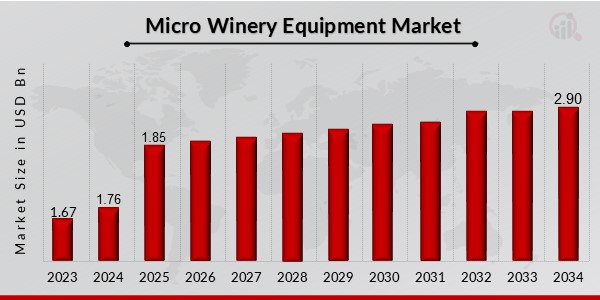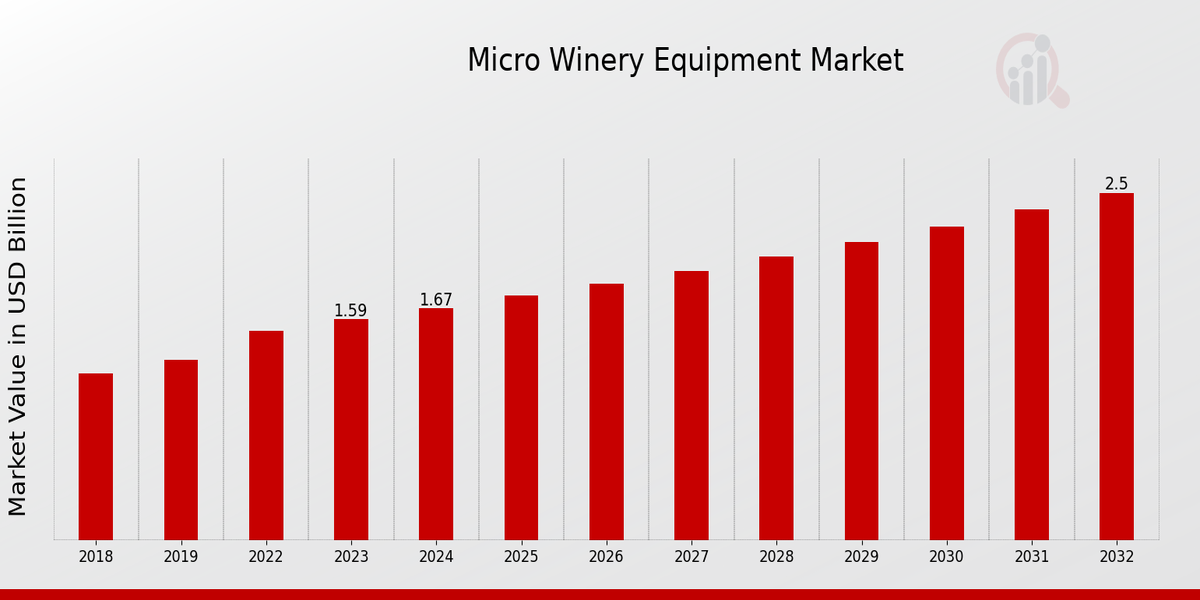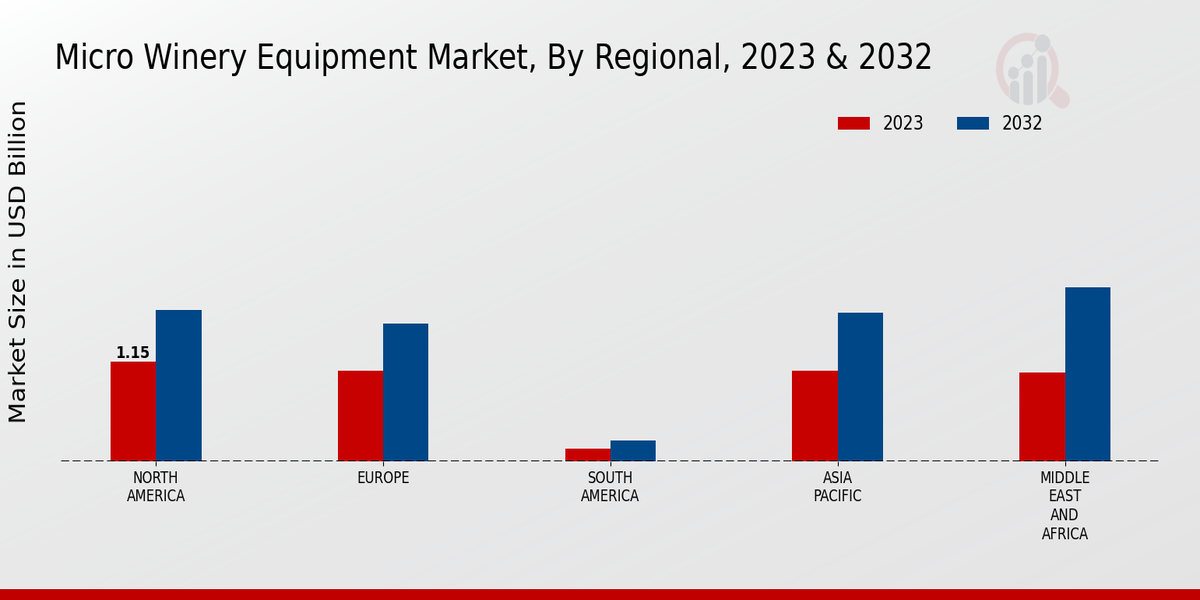Global Micro Winery Equipment Market Overview
Micro Winery Equipment Market Size was estimated at 1.76 (USD Billion) in 2024. The Micro Winery Equipment Industry is expected to grow from 1.85(USD Billion) in 2025 to 2.90 (USD Billion) by 2034. The Micro Winery Equipment Market CAGR (growth rate) is expected to be around 5.2% during the forecast period (2025 - 2034).

Source: Primary Research, Secondary Research, MRFR Database and Analyst Review
Key Micro Winery Equipment Market Trends Highlighted
Key Market Drivers
Growing consumer interest in unique and locally sourced beverages is driving the rise of artisanal and craft wines in the market. The increasing trend of home wine-making and the rise in the number of micro wineries is also creating demand for equipment.
Opportunities to be Explored
The incorporation of new technologies, such as remote monitoring and data analytics in micro winery equipment, presents the opportunity for IoT and automation to improve efficiency in micro wineries. Moving into new regions, in particular, the APAC and South America regions, which are already exhibiting promising crafts and wine industries, offers a great growth opportunity.
Recent Market Trends
Increasing use of eco-friendly practices also encourages the demand for green equipment solutions from micro wineries. The rise in the requirement for lengthy equipment that meets the end user's specifications in terms of production and allocation of space is also a marketing trend. E-commerce and online catalogs are now presenting a more convenient way for micro wineries to acquire equipment, thus enhancing their growth.
Micro Winery Equipment Market Drivers
Rising Demand for Craft and Artisan Wines
The growing popularity of craft and artisan wines has led to increased demand for micro winery equipment. Craft and artisan wines are typically produced in small batches using traditional methods. This has led to a growing demand for specialized equipment that can be used to produce these wines. In addition, the growing popularity of wine tourism has also contributed to the demand for micro winery equipment. As more and more people visit wineries, they are becoming more interested in learning about the wine-making process.This has led to increased demand for equipment that can be used for educational purposes.
Technological Advancements
Technological advancements have also played a role in the growth of the micro winery equipment market. The development of new and innovative equipment has made it easier and more efficient to produce craft and artisan wines. For example, the development of automated fermentation systems has made it possible to produce wine with greater consistency and quality. In addition, the development of new grape sorting and crushing equipment has made it possible to produce wine with fewer defects.These technological advancements have made it possible for micro wineries to compete with larger wineries in terms of quality and price.
Government Support
Government support has been another important driver of the growth of the micro winery equipment market. Many governments around the world have implemented a range of policies that are designed to support small businesses. Such policies usually include tax breaks, grants, and loans. Additionally, many states have also implemented a range of laws and regulations that make it easier for small wineries to operate. Those laws cover a range of issues, including zoning and farm laws, as well as environmental protection regulations.In general, it leads to a more hospitable business environment for small wineries, which results in the increasing demand for micro winery equipment.
Micro Winery Equipment Market Segment Insights
Micro Winery Equipment Market Type of Equipment Insights
The Micro Winery Equipment Market segmentation by type of equipment offers insights into the diverse range of equipment utilized in the production of wine at micro wineries. The market is categorized into five primary segments: Crushing and Destemming Equipment: This equipment is employed in the initial stages of wine-making to crush grapes and separate the stems from the must. The gmarket for crushing and destemming equipment is estimated to reach USD 123.4 million by 2024, exhibiting a steady growth rate due to the increasing demand for automated and efficient equipment.Presses: Presses are vital for extracting juice from crushed grapes. The market for presses is projected to expand at a CAGR of 4.8% during the forecast period, reaching a valuation of USD 78.2 million by 2024. This growth can be attributed to the rising adoption of membrane presses, which offer higher juice yield and improved wine quality. Fermentation and Storage Tanks: Fermentation tanks provide a controlled environment for yeast to convert grape juice into wine. The market for fermentation and storage tanks is anticipated to grow significantly, reaching USD 154.6 million by 2024.This growth is driven by the increasing demand for stainless steel tanks, which offer durability and ease of cleaning. Temperature Control Equipment: Temperature control is crucial for maintaining optimal fermentation conditions. The market for temperature control equipment is expected to witness steady growth, reaching USD 45.3 million by 2024. This growth is primarily driven by the adoption of advanced temperature control systems that ensure precise temperature regulation. Bottling and Labeling Equipment: Bottling and labeling equipment is essential for packaging and branding wine.The market for bottling and labeling equipment is projected to grow at a CAGR of 5.6% during the forecast period, reaching a valuation of USD 67.1 million by 2024. This growth is fueled by the rising demand for automated bottling and labeling machines that enhance efficiency and productivity. The Micro Winery Equipment Market segmentation by type of equipment provides valuable insights into the specific equipment needs of micro wineries. This information can assist manufacturers and distributors in developing targeted strategies to cater to the evolving demands of this growing industry.

Source: Primary Research, Secondary Research, MRFR Database and Analyst Review
Micro Winery Equipment Market Capacity Insights
The Micro Winery Equipment Market is segmented by capacity into small (500-5,000 gallons), medium (5,000-50,000 gallons), and large (over 50,000 gallons). The small capacity segment is expected to account for the largest share of the market in 2023, owing to the increasing popularity of small-scale wineries. Medium capacity segment is projected to grow at the highest CAGR during the forecast period, driven by the growing demand for high-quality wines from medium-sized wineries. Large capacity segment is expected to witness steady growth over the forecast period, as large wineries continue to invest in automation and efficiency improvements.Key insights: The small capacity segment is expected to reach a market valuation of USD 0.6 billion by 2032, growing at a CAGR of 4.5%. The medium capacity segment is expected to reach a market valuation of USD 0.8 billion by 2032, growing at a CAGR of 5.5%. The large capacity segment is expected to reach a market valuation of USD 0.4 billion by 2032, growing at a CAGR of 4.0%. The growth of the micro winery equipment market is driven by factors such as the increasing demand for craft wines, the growing popularity of small-scale wineries, and the rising awareness of the benefits of using high-quality equipment.
Micro Winery Equipment Market Intended Use Insights
The Intended Use segment of the Micro Winery Equipment Market is categorized into Wine Production, Fruit Wine Production, Mead Production, and Cider Production. Wine Production dominates the market, accounting for over 55% of the revenue in 2023. The growing demand for premium wines and the increasing popularity of home wine-making are driving the growth of this segment. Fruit Wine Production is expected to witness a significant growth rate during the forecast period, owing to the rising popularity of artisanal fruit wines and the expansion of the craft beverage industry.Mead Production, known for its historical significance and unique flavor profile, is projected to grow steadily, driven by the increasing demand for traditional and fermented beverages. Cider Production is anticipated to show moderate growth, influenced by the growing demand for artisanal ciders and the increasing popularity of craft breweries.
Micro Winery Equipment Market Automation Insights
Automation in micro winery equipment plays a significant role in enhancing productivity and efficiency. The Micro Winery Equipment Market segmentation by automation level includes Manual, Semi-Automated, and Fully Automated. Manual equipment requires manual labor for operation, while semi-automated equipment combines manual and automated processes. Fully automated equipment operates independently with minimal human intervention. In 2023, the Semi-Automated segment held the largest market share due to its cost-effectiveness and flexibility.With a projected CAGR of 5.5%, it is estimated to reach a valuation of USD 624.3 million by 2032. Fully Automated equipment, though more expensive, is gaining popularity as it reduces labor costs and improves quality control. This segment is expected to reach USD 478.3 million by 2032, with a CAGR of 4.8%. Despite its lower adoption rate, Manual equipment remains relevant for small-scale wineries seeking affordable options.
Micro Winery Equipment Market Regional Insights
North America held the largest share of the Micro Winery Equipment Market in 2023 and is expected to continue to dominate the market throughout the forecast period. The growth of the North American market is attributed to the increasing popularity of craft beer and wine, as well as the growing number of microbreweries and wineries in the region. Europe is the second-largest market for micro winery equipment and is expected to experience significant growth in the coming years. The growth of the European market is being driven by the increasing demand for high-quality wines, as well as the growing number of microbreweries and wineries in the region.The APAC region is expected to be the fastest-growing market for micro winery equipment over the forecast period. The growth of the APAC market is being driven by the increasing demand for wine in the region, as well as the growing number of microbreweries and wineries in the region. South America and MEA are expected to experience moderate growth in the coming years. The growth of the South American and MEA markets is being driven by the increasing demand for wine in the region, as well as the growing number of microbreweries and wineries in the region.

Source: Primary Research, Secondary Research, MRFR Database and Analyst Review
Micro Winery Equipment Market Key Players And Competitive Insights
Major players in the micro winery equipment market are investing in research and development to enhance their product offerings and gain a competitive edge. Leading Micro Winery Equipment Market players are focusing on developing innovative products that cater to the specific needs of micro wineries. The Micro Winery Equipment Market is witnessing the emergence of new players who are offering cost-effective solutions to cater to the growing demand from small-scale wineries. These new entrants are challenging the established players by offering a wider range of products and services at competitive prices. The Micro Winery Equipment Market industry is characterized by intense competition, with both established and new players vying for market share.Bucher Vaslin is a leading supplier of wine-making equipment and solutions. The company offers a wide range of equipment for micro wineries, including grape crushers, destemmers, presses, and tanks. Bucher Vaslin has a strong reputation for quality and innovation, and its products are used by many of the world's leading wineries. The company has a presence, with manufacturing facilities in France, Italy, Spain, and the United States. Bucher Vaslin is committed to providing its customers with the best possible products and services, and it is constantly investing in research and development to improve its offerings.A leading competitor of Bucher Vaslin is Della Toffola. Della Toffola is an Italian company that offers a wide range of wine-making equipment, including grape crushers, destemmers, presses, and tanks. The company has a strong presence in Europe, and it is also expanding its presence in North America and Asia. Della Toffola is known for its high-quality products and its commitment to customer service. The company offers a wide range of services, including installation, maintenance, and training. Della Toffola is a strong competitor to Bucher Vaslin, and it is likely to continue to challenge the company for market share in the years to come.
Key Companies in the Micro Winery Equipment Market Include
-
SPX Flow
-
ABB
-
Rockwell Automation
-
Schneider Electric
-
Bucher Industries
-
Endress+Hauser
-
Tetra Pak
-
GEA Group
-
Emerson Electric
-
Alfa Laval
-
Xylem
-
Siemens
-
Danfoss
-
Pentair
-
KHS GmbH
Micro Winery Equipment Market Industry Developments
Recent developments in the Micro Winery Equipment Market include the growing adoption of sustainable wine-making practices, the increasing popularity of small-batch wines, and the rising demand for automated and efficient equipment. In 2023, the market was valued at approximately USD 1.59 billion, and it is projected to grow at a CAGR of 5.16% from 2024 to 2032, reaching a valuation of USD 2.5 billion by the end of the forecast period. Key market players are focusing on product innovation and expansion into emerging markets to capitalize on the growing demand for micro winery equipment.
Micro Winery Equipment Market Segmentation Insights
-
Micro Winery Equipment Market Type of Equipment Outlook
- Crushing and Destemming Equipment
- Presses
- Fermentation and Storage Tanks
- Temperature Control Equipment
- Bottling and Labeling Equipment
-
Micro Winery Equipment Market Capacity Outlook
- Small (500-5,000 gallons)
- Medium (5,000-50,000 gallons)
- Large (over 50,000 gallons)
-
Micro Winery Equipment Market Intended Use Outlook
- Wine Production
- Fruit Wine Production
- Mead Production
- Cider Production
-
Micro Winery Equipment Market Automation Outlook
- Manual
- Semi-Automated
- Fully Automated
-
Micro Winery Equipment Market Regional Outlook
- North America
- Europe
- South America
- Asia Pacific
- Middle East and Africa
| Report Attribute/Metric |
Details |
| Market Size 2024 |
1.76(USD Billion) |
| Market Size 2025 |
1.84(USD Billion) |
| Market Size 2034 |
2.90(USD Billion) |
| Compound Annual Growth Rate (CAGR) |
5.2% (2025 - 2034) |
| Report Coverage |
Revenue Forecast, Competitive Landscape, Growth Factors, and Trends |
| Base Year |
2023 |
| Market Forecast Period |
2025 - 2034 |
| Historical Data |
2019 - 2023 |
| Market Forecast Units |
USD Billion |
| Key Companies Profiled |
SPX Flow, ABB, Rockwell Automation, Schneider Electric, Bucher Industries, Endress+Hauser, Tetra Pak, GEA Group, Emerson Electric, Alfa Laval, Xylem, Siemens, Danfoss, Pentair, KHS GmbH |
| Segments Covered |
Type of Equipment, Capacity, Intended Use, Automation, Regional |
| Key Market Opportunities |
Growing demand for craft wines Increasing number of micro wineries Technological advancements Rising disposable income Expansion of ecommerce platforms |
| Key Market Dynamics |
Rising demand for craft wines, technological advancements increasing urbanization, growing disposable incomes and government support |
| Countries Covered |
North America, Europe, APAC, South America, MEA |
Frequently Asked Questions (FAQ) :
The Micro Winery Equipment Market is estimated to be worth 1.85 billion USD in 2025.
The Micro Winery Equipment Market is projected to grow at a CAGR of 5.2% from 2025 to 2034.
North America is expected to hold the largest market share in the Micro Winery Equipment Market in 2025.
The wine production segment is expected to hold the largest market share in the Micro Winery Equipment Market in 2025.
Some of the key competitors in the Micro Winery Equipment Market include Bucher Industries, GEA Group, Krones AG, and Tetra Pak.
Some of the key trends driving the growth of the Micro Winery Equipment Market include the increasing popularity of craft beer and wine, the growing demand for premium quality wines, and the increasing number of micro wineries.
Some of the challenges facing the Micro Winery Equipment Market include the high cost of equipment, the need for specialized expertise to operate the equipment, and the competition from larger wineries.
The Micro Winery Equipment Market is expected to reach a value of 2.5 billion USD by 2032.
Asia Pacific is expected to have the highest CAGR in the Micro Winery Equipment Market from 2025 to 2034.
Some of the opportunities for growth in the Micro Winery Equipment Market include the increasing demand for craft beer and wine, the growing popularity of wine tourism, and the increasing number of micro wineries.

















